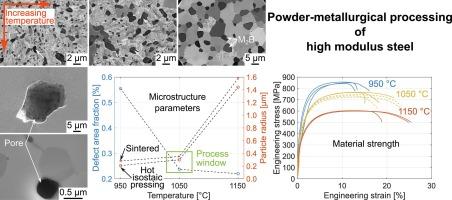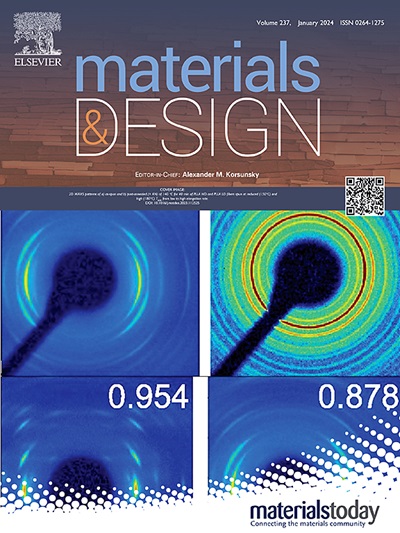Coarsening mechanism of M2B-borides and their effect on the mechanical properties of high modulus steels
IF 7.6
2区 材料科学
Q1 MATERIALS SCIENCE, MULTIDISCIPLINARY
引用次数: 0
Abstract
Size, morphology and distribution of light and stiff, but inherently brittle particles are of critical importance for the property profile of high modulus steels. Powder atomisation can dramatically reduce the borides’ size to the nanoscale, but they typically coarsen substantially during annealing or compaction via hot isostatic pressing. This study investigated the effect of compaction parameters, namely temperature, pressure and time on the coarsening mechanism, porosity evolution and resultant mechanical properties of atomised Fe-Cr-B powder. Increasing annealing temperature and time from 950 to 1150 °C, respectively, 30 min to 8 h, resulted in a non-linear boride radius growth from 76 nm in the atomised state to 1.9 µm. Hot isostatic pressing, with additional pressures up to 140 MPa, decreased the pore size from about 5 to 0.2 µm. An optimised hot isostatic pressing processing window was defined at 1050 °C and 140 MPa, combining sufficiently reduced defects with a limited particle radius, and yielded in 730 MPa tensile strength at more than 20 % tensile elongation. Powder-metallurgical synthesis of Fe-Cr-B achieved similar properties to casted and hot-rolled material, by avoiding component size scaling effects of casting. The underlying phenomena and optimisation of high modulus steel production via powder metallurgy are discussed.

M2B 硼化物的粗化机理及其对高模量钢机械性能的影响
对于高模量钢材的性能特征而言,轻质、坚硬但本质上较脆的颗粒的尺寸、形态和分布至关重要。粉末雾化可将硼化物的尺寸大幅缩小至纳米级,但在退火或通过热等静压进行压制时,硼化物通常会大幅变粗。本研究调查了压实参数(即温度、压力和时间)对雾化铁-铬-硼粉末的粗化机制、孔隙率演变和由此产生的机械性能的影响。将退火温度和时间分别从 950°C 提高到 1150°C、30 分钟到 8 小时,可使硼化物半径从雾化状态的 76 纳米非线性增长到 1.9 微米。热等静压(附加压力高达 140 兆帕)使孔径从约 5 微米减小到 0.2 微米。在 1050 °C 和 140 MPa 的温度下,确定了一个优化的热等静压加工窗口,将充分减少缺陷和限制颗粒半径结合起来,在拉伸伸长率超过 20% 的情况下产生 730 MPa 的抗拉强度。粉末冶金合成的 Fe-Cr-B 具有与铸造和热轧材料相似的性能,避免了铸造的成分尺寸缩放效应。本文讨论了通过粉末冶金生产高模量钢的基本现象和优化方法。
本文章由计算机程序翻译,如有差异,请以英文原文为准。
求助全文
约1分钟内获得全文
求助全文
来源期刊

Materials & Design
Engineering-Mechanical Engineering
CiteScore
14.30
自引率
7.10%
发文量
1028
审稿时长
85 days
期刊介绍:
Materials and Design is a multi-disciplinary journal that publishes original research reports, review articles, and express communications. The journal focuses on studying the structure and properties of inorganic and organic materials, advancements in synthesis, processing, characterization, and testing, the design of materials and engineering systems, and their applications in technology. It aims to bring together various aspects of materials science, engineering, physics, and chemistry.
The journal explores themes ranging from materials to design and aims to reveal the connections between natural and artificial materials, as well as experiment and modeling. Manuscripts submitted to Materials and Design should contain elements of discovery and surprise, as they often contribute new insights into the architecture and function of matter.
 求助内容:
求助内容: 应助结果提醒方式:
应助结果提醒方式:


